Статьи журнала - Вестник Южно-Уральского государственного университета. Серия: Химия
Все статьи: 514
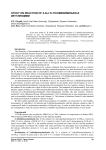
Study on reaction of 2-allylthiobenzimidazole with bromine
Статья научная
It has been found by 1Н NMR method that bromination of 2-allylthio-benzimidazole proceeds to give the bromocyclization products (benzimidazo-[2,1 b]thiazolium and benzimidazo[2,1-b][1,3]thiazinium bromides) and two isomeric products of bromine addition to the double bond of allyl moiety.
Бесплатно
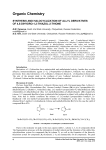
Synthesis and halocyclization of allyl derivatives of 4,5-dihydro-1,3-thiazol-2-thione
Статья научная
2-Propenyl-(2-methyl-1-propenyl-, 2-butenylthio- and (3-methylbutenyl-)thio4,5-dihydro-1,3-thiazoles are synthesized by alkylation of 4,5-dihydro-1,3-thiazol2-thione. These products were researched in halocyclization reactions with iodine and bromine.3-(halomethyl)-2,3,5,6-tetrahydrothiazolo[2,3-b]thiazolium and 6-halo-3,5,6,7-tetrahydro-2H-thiazolo[2,3-b]thiazinium halides were formed. The structure of all the synthesized compounds was confirmed by 1H NMR and gas chromatography-mass spectrometry.
Бесплатно
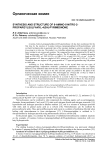
Synthesis and structure of 6-amino-5-nitro-2-propargylsulfanyl-4(3H)-pyrimidinone
Статья научная
6-Amino-5-nitro-2-propargylsulfanyl-4(3 H )-pyrimidinone (1) has been synthesized for the first time by the reaction of 6-amino-5-nitroso-2-propargylsulfanyl-4(3 H )-pyrimidinone with tert -butyl hydroperoxide at equimolar ratio of the reactants leading to selective oxidation of nitroso group to a nitro one. The product is a crystalline substance, soluble in aromatic hydrocarbons, resistant to air oxygen and moisture. The compound has been characterized by IR and 1H NMR spectroscopy and X-ray diffraction analysis. The IR spectrum of 1 contains absorption bands at 3290 (NH2, st ), 2855 (S-CH2, st ), 1684 (C=O, st ) and 1595 (NO2, st ) cm-1. In the 1H NMR spectrum of 1 there are singlets of SCH2 protons at 3.87 ppm and С≡CH at 3.12 ppm. Downfield, there are singlets of NH2 group protons at 7.77 ppm and pyrimidine ring NH protons at 10.89 ppm. According to X-ray diffraction analysis data, in the crystal there are two types of crystallographically independent molecules, geometrical parameters of which are slightly different. X-ray diffraction data show that the crystal cell contains molecules of the used solvent, dimethylformamide. The planes of the nitro and thio groups are parallel to the plane of the heterocyclic fragment. C-NO2 and C-NH2 bond lengths are 1.452(2) and 1.317(2) Å, which is usual for compounds of these classes. The CAr-S distance is 1.748(2) Å. The structural arrangement of molecules in a crystal is due to O···H hydrogen bonding (1.91(2)-2.70(1) Å) and intermolecular N···O interactions (2.767(3)-2.984(3) Å). Also, there are face-to-face stacking interactions, the distances between centroids of aromatic rings are 4.13-4.46 Å.
Бесплатно
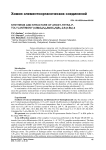
Synthesis and structure of aroxy-tetra- p-tolylantimony (4-MeC 6H 4) 4SbOC 6H 2Br 2-2,6-(t-Bu)-4
Статья научная
Penta-p-tolylantimony interaction with 2,6-dibromo(4-tert-butyl)phenol has led to syn-thesis of the complex tetra-p-tolylantimony 2,6-dibromo(4-tert-butyl)phenoxide, whose structure has been established by X-ray diffraction. The antimony atom in the molecule (4-MeC 6H 4) 4SbOC 6H 2Br 2-2,6-(t-Bu)-4 has distorted trigonal-bipyramidal coordination with the aroxy group in axial position. The bond Sb-O is 2.229(2) Å, the axial angle CSbO is 176.82(10)°.
Бесплатно
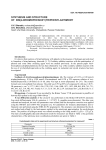
Synthesis and structure of bis(4-bromophenoxy)triphenylantimony
Статья научная
Interaction of triphenylantimony with 4-bromophenol in the presence of tert-butylhydroperoxide in ether has led to the synthesis of bis(4-bromophenoxy)triphenylantimony, whose structure has been established by X-ray diffraction analysis. The antimony atom has distorted trigonal-bipyramidal coordination with aroxy groups in axial positions. The bond lengths equal: 2.094(4), 2.108(5), 2.109(5) Å for Sb-C; 2.062(4) and 2.066(3) Å for Sb-O. The axial angle OSbO equals 172.41(1)°.
Бесплатно
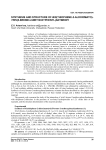
Synthesis and structure of bis(thiophene-2-aldoximato)-tris(5-bromo-2-methoxyphenyl)antimony
Статья научная
Synthesis of bis (thiophene-2-aldoximato) tris (5-bromo-2-methoxyphenyl)antimony (1) has been carried out by the oxidative addition reaction of tris (5-bromo-2-methoxyphenyl)antimony with thiophene-2-aldoxime in the presence of tert -butyl hydroperoxide with the 1:2 molar ratio of the reactants. The compound has been characterized by IR spectroscopy and X-ray diffraction analysis. According to the X-ray diffraction analysis data, in the crystal there are two types of crystallographically independent the molecules, geometrical parameters of which are slightly different. Coordination polyhedron of antimony atoms in a molecule is a distorted trigonal bipyramid. The sum of the СSbC angles equals 360°, the values of the individual angles differ from the theoretical 120° by no more than 8.6(8)°. The axial OSbO angle is 175.8(4)°. The OSbC angles vary within the range 85.8(6)º-97.6(6)º. The average value of the Sb-C bond lengths is 2.13(2) Å. The Sb-O distances equal 2.08(1) Å. The distances between the Sb atom and N atoms of the iminoxy groups are 2.80(2)-2.94(2) Å. The distances between the N and O atoms do not depend on the distances between the Sb and N atoms; they are equal to 1.39(2)-1.43(2) Å. In the molecules there are contacts between the Sb and O atoms of methoxy groups, the corresponding distances are within the range of 3.13(1)-3.23(1) Å. The molecules in a crystal are connected by intermolecular hydrogen bonds between the aromatic H and Br (2.883 Å), S (2.992 Å) and N (2.715 Å) atoms. In the molecules there are intramolecular short contacts between the iminoxy group O atom and S (2.72(1)-2.80(1) Å), as well as the methoxy group O atom (2.93(2)-3.03(2) Å).
Бесплатно
![Synthesis and structure of bismuth complexes [p-Tol 4E] +3[Bi 3I 12] 3-•HOCH 2CH 2OC 2H 5 E=P, Sb Synthesis and structure of bismuth complexes [p-Tol 4E] +3[Bi 3I 12] 3-•HOCH 2CH 2OC 2H 5 E=P, Sb](/file/thumb/147160329/synthesis-and-structure-of-bismuth-complexes-p-tol-4e-3-bi-3i-12-3-hoch-2ch.png)
Synthesis and structure of bismuth complexes [p-Tol 4E] +3[Bi 3I 12] 3-•HOCH 2CH 2OC 2H 5 E=P, Sb
Статья научная
The interaction of equimolar amounts of tetra- p-tolylphosphonium and tetra- p-tolylstybonium iodides with bismuth triiodide in 2-ethoxyethanol leads to formation of the complexes [p-Tol 4E] +3[Bi 3I 12] 3-∙HOCH 2CH 2OC 2H 5 E=P (I), Sb (II). X-ray diffraction analysis of compounds (I) and (II) has shown that in the cations of complexes I and II the coordination of phosphorus and antimony atoms is tetrahedral (angles equal: CPC 107.3(3)°-113.4(4)° (I), CSbC 105.4(3)°-113.7(3)° (II); bond lengths for P-C and Sb-C are 1.761(9)-1.815(7) Å and 2.085(8)-2.099(8) Å, respectively). In trinuclear anions [Bi 3I 12] 3- the terminal fragments BiI 3 (Bi-Iterm 2.8714(5)-2.9181(5) Å (I), 2.8867(5)-2.9248(6) Å (II)) are bonded to the central bismuth atom through six μ2-bridging iodine atoms (Bi-Ibr 3.0454(6)-3.3891(6) Å (I), 3.0595(4)-3.3694(6) Å (II)).
Бесплатно
![Synthesis and structure of gold complexes [ p-Tol 4Sb][ p-TolAuCl 3] and [ p-Tol 4Sb][AuCl 4] Synthesis and structure of gold complexes [ p-Tol 4Sb][ p-TolAuCl 3] and [ p-Tol 4Sb][AuCl 4]](/file/thumb/147160338/synthesis-and-structure-of-gold-complexes-p-tol-4sb-p-tolaucl-3-and-p-tol-4sb.png)
Synthesis and structure of gold complexes [ p-Tol 4Sb][ p-TolAuCl 3] and [ p-Tol 4Sb][AuCl 4]
Статья научная
Gold complexes [ p-Tol 4Sb] +[ p-TolAuCl 3] - (1) and [ p-Tol 4Sb] +[AuCl 4] - (2) have been synthesized by interaction of tetra- para-tolylstibonium chloride and aurichlorohydric acid tetrahydrate in acetone. In 1 the tetra- para-tolylstibonium cations are tetrahedral (Sb-C 2.091(7)-2.097(6) Å, CSbC 106.1(3)°-112.7(3)°), the [p-TolAuCl3]- anions have square-planar structure (Au-Cl 2.286(2)-2.389(2) Å, Au-C 2.028(7) Å, ClAuCl 89.92(9)°, 92.42(9)°, 176.68(8)°, CAuCl 88.27(18)°, 89.57(18)°, 175.59(19)°). In crystal 2 the geometrical characteristics of cations (Sb-C 2.076(7)-2.097(9), CSbC 106.5(3)°-111.5(4)°) and [AuCl 4] - square-planar anions (Au-Cl 2.248(3)-2.278(3) Å, ClAuCl 89.17(9)°-90.74(13)°, 177.24(16)°, 177.61(13)°) are similar to those in 1.
Бесплатно
![Synthesis and structure of iodotris(tryphenylstibine)silver [(Ph 3Sb) 3AgI] Synthesis and structure of iodotris(tryphenylstibine)silver [(Ph 3Sb) 3AgI]](/file/thumb/147160344/synthesis-and-structure-of-iodotris-tryphenylstibine-silver-ph-3sb-3agi.png)
Synthesis and structure of iodotris(tryphenylstibine)silver [(Ph 3Sb) 3AgI]
Статья научная
Interaction of silver iodide with triphenylstibine in dimethyl sulfoxide has led to the neutral complex iodotris(triphenylstibine)silver (1), whose structure has been established by X-ray diffraction analysis. The silver atom has distorted tetrahedral coordination. The angles SbAgSb and SbAgI equal 106.501(13)°, 109.644(13)°, 111.099(13)° и 103.063(13)°, 111.594(14)°, 114.337(14)°, the bond lengths Ag-Sb and Ag-I equal 2.7291(4), 2.7326(4), 2.8087(4) и 2.7600(4) Å.
Бесплатно
![Synthesis and structure of iridium complex [Ph 4Sb(DMSO)] +[IrCl 4(DMSO) 2] - Synthesis and structure of iridium complex [Ph 4Sb(DMSO)] +[IrCl 4(DMSO) 2] -](/file/thumb/147160334/synthesis-and-structure-of-iridium-complex-ph-4sb-dmso-ircl-4-dmso-2.png)
Synthesis and structure of iridium complex [Ph 4Sb(DMSO)] +[IrCl 4(DMSO) 2] -
Статья научная
Iridium complex [Ph 4Sb(DMSO)] +[IrCl 4(DMSO) 2] - (1) has been synthesized by interaction of tetraphenylstibonium chloride with sodium hexachloroiridate(III) in water. From X-ray diffraction analysis data, two types of crystallographically independent cations [Ph 4Sb(DMSO)] + and anions [IrCl 4(DMSO) 2] - exist in the crystal. The antimony atoms in cations have distorted trigonal-bipyramidal surroundings with O-dimethyl sulphoxide ligand in axial position (equatorial angles CSbC 113.6(2)°-121.2(2)°, axial angles CSbО 178.33(18)°, 176.47(18)°, bond lengths Sb-С eq 2.106(6)-2.119(6) Å, Sb-С ax 2.126(6), 2.130(6) Å, Sb-О 2.545(4), 2.465(4) Å). In mononuclear octahedral anions the equatorial positions are occupied by chlorine atoms (angles ClIrCl- trans 178.69(7)°-179.56(7)°, SIrS- trans 178.35(7)°, 175.88(7)°; dimethyl sulfoxide ligands are coordinated with iridium atoms through sulfur atoms (Ir-S 2.2958(16)-2.3148(17) Å), bond lengths Ir-Cl vary in the range 2.3407(19)-2.3681(17) Å. The structural organization in the crystal is determined by interionic hydrogen bonds (H∙∙∙Cl 2.80-2.94 Å and H∙∙∙O 2.56-2.71 Å).
Бесплатно
![Synthesis and structure of osmium complex [Ph 4P] 2[OsBr 6] Synthesis and structure of osmium complex [Ph 4P] 2[OsBr 6]](/file/thumb/147160324/synthesis-and-structure-of-osmium-complex-ph-4p-2-osbr-6.png)
Synthesis and structure of osmium complex [Ph 4P] 2[OsBr 6]
Статья научная
Tetraphenylphosphonium hexabromoosmate, [Ph 4P] 2[OsBr 6] (I), has been structurally characterized after synthesis by interaction of sodium hexabromoosmate with tetraphenylphosphonium bromide in dimethyl sulfoxide. The phosphorus atoms of [Ph 4P] + cations have distorted tetrahedral coordination geometry (СPС angles are 106.23(11)°-113.23(10)°), the P-С bond lengths are 1.791(2)-1.801(2) Å). In octahedral [OsBr 6] 2- anions the Os-Br bond lengths equal 2.4752(2)-2.5020(3) Å, trаns-BrOsBr angles are 180°.
Бесплатно
![Synthesis and structure of palladium complex [Ph 3PCH=CHPPh 3] 2+[PdBr 3(DMSO)] -2•DMSO Synthesis and structure of palladium complex [Ph 3PCH=CHPPh 3] 2+[PdBr 3(DMSO)] -2•DMSO](/file/thumb/147160308/synthesis-and-structure-of-palladium-complex-ph-3pchchpph-3-2-pdbr-3-dmso.png)
Synthesis and structure of palladium complex [Ph 3PCH=CHPPh 3] 2+[PdBr 3(DMSO)] -2•DMSO
Статья научная
The palladium complex [Ph 3PCH=CHPPh 3] 2+[PdBr 3∙DMSO] -2∙DMSO (1) has been synthesized by the reaction of palladium dibromide with 1,2-vinylene-bis-triphenylphosphonium dibromide in the presence of hydrobromic acid in water, followed by recrystallization from dimethylsulfoxide. According to the X-ray diffraction data, the phosphorus atoms in cations have a slightly distorted tetrahedral environment (CPC 107.8(3)°-111.7(3)° Å), the P-С bond lengths are 1.779(6)-1.816(5) Å. In the square planar anions, the SPdBr trans-angles are 176.89(5)° and 178.11(6)° Å, and the BrPdBr trans-angles are 177.59(4)° and 177.82(3)° Å. Dimethylsulfoxide ligands are coordinated to the Pd atoms by the sulfur atoms: the Pd-S bond lengths are 2.2634(17) and 2.2666(18) Å, the Pd-Br bond lengths lie in the range of 2.4200(18)-2.4486(9) Å. Structural organization of the crystal is caused by the interionic H∙∙∙Br (2.90-3.02 Å) and H∙∙∙O (2.30-2.56 Å) hydrogen bonds.
Бесплатно
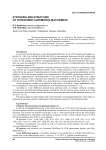
Synthesis and structure of tetraphenylantimony β-isatoximate
Статья научная
(β-Isatoximato)tetraphenylantimony (1) was obtained by the reaction of pentaphenylantimony with β-isatoxime. X-ray diffraction analysis showed that the antimony atom in complex 1 had distorted trigonal-bipyramidal coordination.
Бесплатно
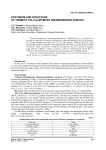
Synthesis and structure of tri(meta-tolyl)antimony bis(benzenesulfonate)
Статья научная
Tri( meta-tolyl)antimony bis(benzenesulfonate) m-Tol 3Sb(OSO 2C 6H 5) 2 (1) has been synthesized by interaction of tri( meta-tolyl)antimony with benzenesulfonic acid in the presence of tert-butyl hydroperoxide (mole ratio 1:2:1) in ether solution. Antimony atoms in 1 have trigonal-bipyramidal coordination with arenesulfonate substituents in axial positions (OSbO 171.05(11)°, CSbC 116.21(19)°, 117.38(18)°, 126.40(15)°). The Sb-C and Sb-O distances equal 2.091(4), 2.098(4), 2.115(4) and 2.105(2), 2.116(3) Å. Intermolecular contact (Sb•••O 3.421(3) Å) occurs between the central atom and the oxygen atom of sulfonate group.
Бесплатно
![Synthesis and structure of tri- and tetraphenylantimony aroxides: Ph 3Sb[OC 6H 3(Br 2-2,6)(Me-4)] 2 and Ph 4SbOC 6H 3Br 2-2,6, Me-4 Synthesis and structure of tri- and tetraphenylantimony aroxides: Ph 3Sb[OC 6H 3(Br 2-2,6)(Me-4)] 2 and Ph 4SbOC 6H 3Br 2-2,6, Me-4](/file/thumb/147160335/synthesis-and-structure-of-triand-tetraphenylantimony-aroxidesph-3sb-oc-6h-3.png)
Статья научная
Interaction of pentaphenylantimony with 2,6-dibromo,4-methylphenol or with bis(2,6-dibromo,4-methylphenoxy)triphenylantimony (1) leads to formation of 2,6-dibromo,4-methylphenoxytetraphenylantimony (2). In molecules of compounds 1 and 2 the antimony atoms have distorted trigonal-bipyramidal coordination with the oxygen atoms in axial positions (OSbO 179.20(15)° (1), OSbC 179.7(9)° (2)). The bond lengths Sb-C and Sb-O equal 2.090(5), 2.101(5), 2.110(5) and 2.088(4), 2.088(4) Å (1), 2.11(2), 2.11(2), 2.11(2), 2.17(3) and 2.234(18), 2.234(18) Å (2), respectively.
Бесплатно
![Synthesis and structure of µ2-oxo-bis [(pentafluoropropionato)-tris(5-bromo-2-methoxyphenyl)antimony] Synthesis and structure of µ2-oxo-bis [(pentafluoropropionato)-tris(5-bromo-2-methoxyphenyl)antimony]](/file/thumb/147233139/synthesis-and-structure-of-2-oxo-bis-pentafluoropropionatotris.png)
Статья научная
The synthesis of μ2-oxo- bis [(pentafluoropropionato) tris (5-bromo-2-methoxyphenyl)antimony] (1) has been curried out by the oxidative addition reaction of tris (5-bromo-2-methoxyphenyl)antimony with pentafluoropropionic acid in the presence of hydrogen peroxide at an equimolar ratio of reactants. The compound is characterized by IR spectroscopy and X-ray diffraction analysis. According to X-ray diffraction data, there are two types of crystallographically independent molecules with slightly different geometrical parameters in the crystal. The antimony atoms in each molecule are linked by the bridging oxygen atom (the SbOSb angle is 167.6(7)°). The trigonal bipyramidal coordination of antimony atoms is distorted; the axial OSbO angles are 175.9(4)°, 174.5(4)° for Sb(1) and Sb(2) atoms, respectively. The sums of valence CSbC angles in the equatorial planes are 359.6(6)° and 356.4(6)°. The mean values of the Sb(1)-C and Sb(2)-C bond lengths are 2.12(2) Å, the Sb-O( μ 2) distances are 1.89(1), 1.98(1) Å. The carboxylate ligands in each molecule are monodentate. The distances between the antimony atoms and the corresponding terminal oxygen atoms are 2.22(1), 2.39(1) Å, the Sb···O=C distances are 3.38(2), 3.71(1) Å. The d(Sb···O=C)/d(Sb-О) ratios, which can be used to estimate the asymmetry of the ligand related to metal atom coordination, are 1.67 and 1.41. In crystal 1 there are such contacts as Sb···OMe (2.88(1)-3.16(1), 3.01(1)-3.20(1) Å), hydrogen bonds involving halogen atoms H···F (2.16, 2.50, 2.58 Å), H···Br (2.92, 2.96, 3.04 Å) and carbonyl oxygen atoms H···О (2.43, 2.59 Å), as well as halogen···halogen F···F interactions (2.70, 2.71 Å).
Бесплатно
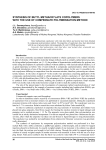
Synthesis of butyl methacrylate copolymers with the use of compensate polymerization method
Статья научная
Butyl methacrylate copolymers with vinyl alkyl ethers and styrene have been obtained by compensate polymerization method. The properties of copolymers have been determined with the use of gel-penetration chromatography, IR- and 1H NMR-spectroscopy.
Бесплатно
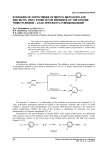
Статья научная
The synthesis of copolymers of methyl methacrylate and butyl vinyl ether using the system tributylboron - 2,5-di-tert-butil-p-benzoquinone has been carried out. This system does not influence the reactivity ratios of these monomers. Predominantly, the terminal unit of butyl vinyl ether reacts with p-quinone. Controlled radical polymerization is realized along with the conventional process.
Бесплатно
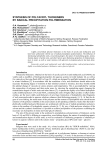
Synthesis of polyacryl thickeners by radical precipitation polymerization
Статья научная
Lightly cross-linked polymer thickeners on the basis of acrylic and methacrylic acid have been synthesized with the use of radical precipitation polymerization. The influence of introducing hydrophobic units, cross-linking degree, the nature of neutralizing agents, neutralization degree of acidic units, and other factors upon thickening properties of obtained polymers in water, as well as water mixtures with glycerol or propylene glycol, has been determined.
Бесплатно
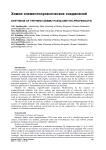
Synthesis of triphenylbismuth bis(2-methylpropenoate)
Статья научная
Triphenylbismuth bis(2-methylpropenoate) Ph 3Bi(O 2CMe=CH 2) 2 has been obtained by the interaction of triphenylbismuth with methacrylic acid and hydrogen peroxide in tetrahydrofuran. Its structure has been determined by IR and 1H NMR spectroscopy.
Бесплатно

